Scotland's Wellbeing: national outcomes for disabled people
Analysis of the National Performance Framework (NPF) outcome indicators from the perspective of disability.
9. Health
We are healthy and active
What we Know:
- Disabled people have lower average mental wellbeing scores than non-disabled people (45 compared to 52 on a scale of 14 to 72).
- Disabled people are more likely to engage in two or more health risk behaviours such as smoking or harmful drinking than non-disabled people.
- A smaller proportion of disabled people meet physical activity recommendations than non-disabled people.
- Similar numbers of disabled people and non-disabled people take part in active travel (which includes the use of public transport along with active methods such as walking and cycling).
- Almost two thirds of both disabled and non-disabled people are clinically overweight.
National outcome
This outcome aims at a whole systems approach to promoting good health and activity. This will mean that people in Scotland live long, healthy and active lives regardless of where they come from through responsible health, diet and physical activity behaviours. It also means that the NHS in Scotland is cherished and protected to allow people access to world class, appropriate and free/affordable physical and mental health, social care and dental services.
National Performance Indicators
There are nine national performance indicators in the health domain. At present, one of these is in development:
- Work related ill health No Indicator at present
For another, the measurement is concerned with the number of years individuals are likely to be in ‘good health’:
- Healthy Life Expectancy (The estimated average number of years that a new born baby could be expected to live in 'good health')
From this perspective, it is unhelpful to distinguish rates between those with and without a long-term limiting health condition. A further two indicators are not broken down in terms of disability status:
- Premature Mortality (European Age Standardised mortality rates per 100,000 for people under 75).
- Quality of Care Experience (Percentage of people who describe the overall care provided by their GP practice as Excellent or Good)
The remaining five, however, have a demographic breakdown that includes disability:
- Mental Wellbeing (Average score on Warwick-Edinburgh Mental Wellbeing Scale (WEMWBS))
- Health Risk Behaviours (Percentage of adults with two or more health risk behaviours (current smoker, harmful drinking, low physical activity, obesity).
- Physical Activity (Percentage of adults meeting physical activity recommendations).
- Journeys by Active Travel (Proportion of adults usually travelling to work by public or active transport)
- Healthy Weight (Percentage of adults (aged 16+) who are a healthy weight).
Mental wellbeing
Disabled people have lower average mental wellbeing scores than non-disabled people. The SHeS measures well-being on the Warwick-Edinburgh mental well-being scale. This score ranges between 14 and 70. In 2017, disabled people[46] had an average score of 45 compared to an average score of 52 for non-disabled people (see Figure 9.1).
Figure 9.1 Average score on the Warwick-Edinburgh Wellbeing Scale in 2017, by disability.
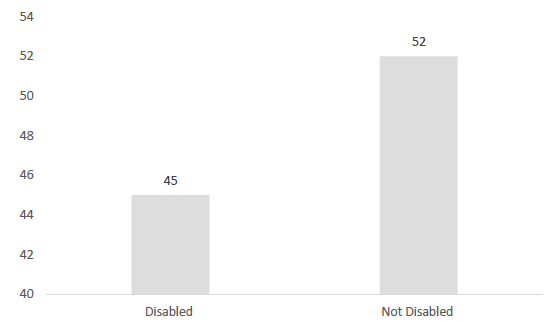
Source: Scottish Health Survey 2017
At the same time, mental health conditions may, in themselves, constitute a form of disability. However, this lower average wellbeing is consistent with other evidence that suggests that there may be an association between long-term conditions and mental health problems.
For instance, in England, the Adult Psychiatric Morbidity Survey 2014 found an association between the presence of at least one chronic physical condition in the past 12 months and having symptoms of a common mental disorder in the past week. This report found that 25.3% of those with no or few symptoms of a common mental disorder had a chronic physical condition. However, in people with severe common mental disorder symptoms, over a third – 37.6% - also had a chronic physical condition.[47] Similarly, a 2012 report from the King’s Fund and Centre for Mental Health found that, in England, 30% of those with a long-term condition also had a mental health problem, and 46% of those with a mental health problem also had a long-term health condition.[48]
Health Risk Behaviours
The SHeS reports that a greater percentage of disabled people engage in two or more health risk behaviours than non-disabled people. Health risk behaviours are defined as being a current smoker, engaging in harmful drinking, low physical activity or obesity. In 2017, around 41% of disabled people reported two or more health risk behaviours, compared to 22% of non-disabled people.
Figure 9.2 Percentage of adults with two or more health risk behaviours in 2017, by disability.
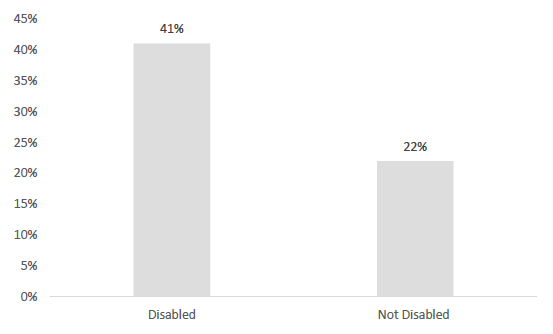
Source: Scottish Health Survey 2017
The higher rates of smoking among disabled people compared to non-disabled people has been demonstrated elsewhere, and may contribute to this disparity.[49]
Physical Activity
The SHeS reported that, in 2017, 49% of disabled people met physical activity recommendations, compared to 73% of non-disabled people (see Figure 9.3).
Figure 9.3 Percentage of the population meeting the recommendations for physical activity in 2017, by disability.
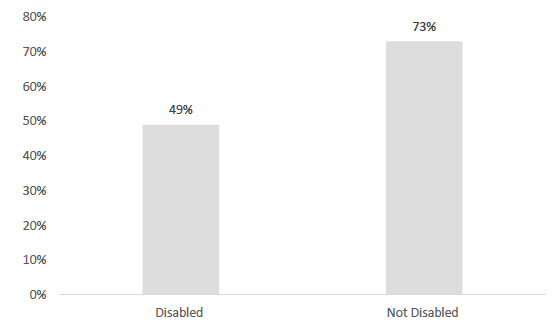
Source: Scottish Health Survey 2017
A rapid evidence review in 2018 produced by the UK Government found that disabled people were twice as likely as non-disabled people to be physically inactive. In England, the rate of inactivity (i.e. less than 30 minutes of exercise a week) was reported as 43% among disabled people, compared to 21% of non-disabled people. The same publication reports that 18% of disabled adults engage in at least one physical activity session per week compared to 41% of non-disabled adults.[50]
Journeys by active travel
The SHS shows that the differences in the use of this transport between disabled and non-disabled people are inconsistent (see Figure 9.4). Pooled across the five year period – 2013-2017 - these differences are not statistically significant.
Figure 9.4 Proportion of adults usually travelling to work by public or active transport, 2013-17 by disability.
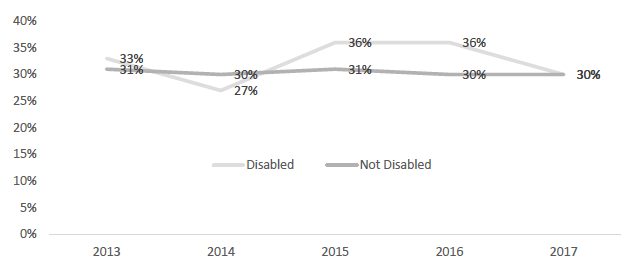
Source: Scottish Household Survey 2017
Healthy Weight
This indicator measures the percentage of adults, i.e. those over 16, who are a healthy weight. Being overweight in this context refers to having a BMI over 25. Statistics on BMIs in the population are available from the SHeS for both children and adults. These figures, however, are provided in three parts, i.e. limiting long-term condition (disability), non-limiting long-term condition and no long-term condition (both of which can be understood as ‘not disabled’.
The data indicates that slightly fewer disabled people have BMIs under 25, compared to these groups, but the differences are small (see Figure 9.5). In 2017, 64% of non-disabled adults with no long-term illnesses had BMIs over 25 (which is considered overweight) compared to 67% of disabled people.[51]
Figure 9.5 Distribution of BMIs under and over 25, in 2017, by disability.
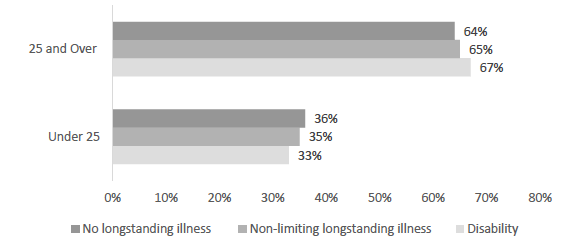
Source: Scottish Health Survey 2017
Overall, 67% of disabled children are at a ‘healthy weight’, compared to 68% of those with non-limiting long-term conditions and 73% of those with no long-term health conditions (both of whom are ‘not disabled’). In general, the differences between children in terms of weight are limited. An important exception is that there are approximately double the number of children with both limiting and non-limiting long-term conditions in the category of ‘morbidly obese’. The number of disabled people in this category is the same as the number of individuals with non-limiting long-term health conditions.
Figure 9.6. Distribution of weights, among children in 2017, by disability.
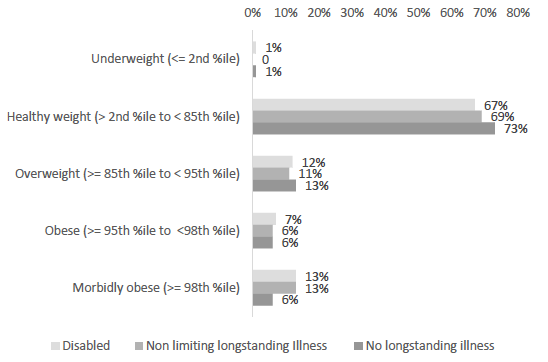
Source: Scottish Health Survey 2017
Alternative Indicators
Premature Mortality
Statistics concerned with premature mortality are not broken down in relation to disability. Research in England, published in 2013, found that men and women with learning disabilities died sooner than those without learning disabilities, by an average of 13 and 20 years respectively.[52] Public Health England also reported that, in 2014-15, people with serious mental illness such as bipolar disorder or schizophrenia had rates of premature mortality 3.7 times higher than the general population.[53]
Quality of care experience
Experiences of care can be measured by the Quality of Care Survey. However, while overall experiences of care are positive, the results are not currently broken down demographically by disability.
Research has, however, indicated that there may be specific concerns for individuals with disabilities. For instance, a 2015 review of learning disability units in Scottish hospitals found that 35% of the patients had a ‘delayed discharge’. This means being kept in hospital in contexts where this was recognised as no longer the best place for them to be living. These delays were frequently associated with a lack of appropriate facilities for patients or the challenges associated with coordinating responses to complex needs.[54]
Contact
Email: joseph.ritchie@gov.scot
There is a problem
Thanks for your feedback